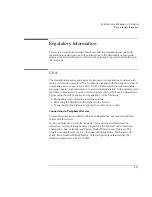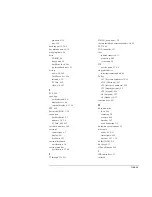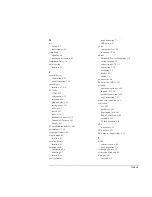
Index-7
System Devices menu (BIOS), 1-13
system resources
DMA channels, 8-7
Input/Output addresses, 8-6
memory, 8-6
system interrupts, 8-6
system-off button
location, 1-6
T
taskbar
battery, 3-4
volume, 2-11
tatooing, 2-22
technical support, 1-2
tested PC Cards, 4-15
time-outs, 1-15, 3-10
TopTools, 1-17
touch pad
configuring, 2-7
location, 1-5
using, 2-6
track point.
See
pointing stick
tray (docking), 4-16
troubleshooting
audio devices, 7-4
battery, 7-11
CD-ROM drive, 7-3
display, 7-5
hard disk drive, 7-6
memory, 7-9
mini dock, 7-3
parallel device, 7-14
performance, 7-10
port replicator, 7-3
power, 7-11
printing, 7-13
serial device, 7-14
startup, 7-15
touch pad, 7-7
U
undocking, 4-19
Universal Serial Bus (USB)
connecting, 4-11
USB port
location, 1-6
User’s Handbook
(online), 1-2
V
VGA output, 1-7, 4-8
video drivers
Windows 95, 6-8
Windows NT 4.0, 6-15
virus scan, 2-20, 7-6
voltage requirements, 8-8
volume
adjusting, 2-11
troubleshooting, 7-4
wheel, 7-4
W
warning (low battery), 3-4
website, 1-2
wheel (volume), 7-4
Windows 95
documentation, 1-2
factory build, 6-4
license agreement, 1-10
setting up, 1-8
Windows 95 (retail)
audio drivers, 6-9
infrared drivers for, 6-10
PC Card drivers for, 6-10
video drivers, 6-8
Windows keys, 2-14
Windows NT 4.0
factory build, 6-5
setting up, 1-8
Windows NT 4.0 (retail)
APM drivers, 6-17
audio drivers, 6-16
Summary of Contents for OMNIBOOK 4150
Page 1: ...HP OmniBook 4100 Reference Guide ...
Page 9: ...1 Introducing the OmniBook ...
Page 26: ......
Page 27: ...2 Operating the OmniBook ...
Page 49: ...3 Managing Battery Power ...
Page 60: ......
Page 61: ...4 Making Connections ...
Page 80: ......
Page 81: ...5 Expanding the OmniBook ...
Page 90: ......
Page 91: ...6 Using the Recovery CD ...
Page 111: ...7 Troubleshooting ...
Page 128: ......
Page 129: ...8 Specifications and Regulatory Information ...
Page 142: ......


































